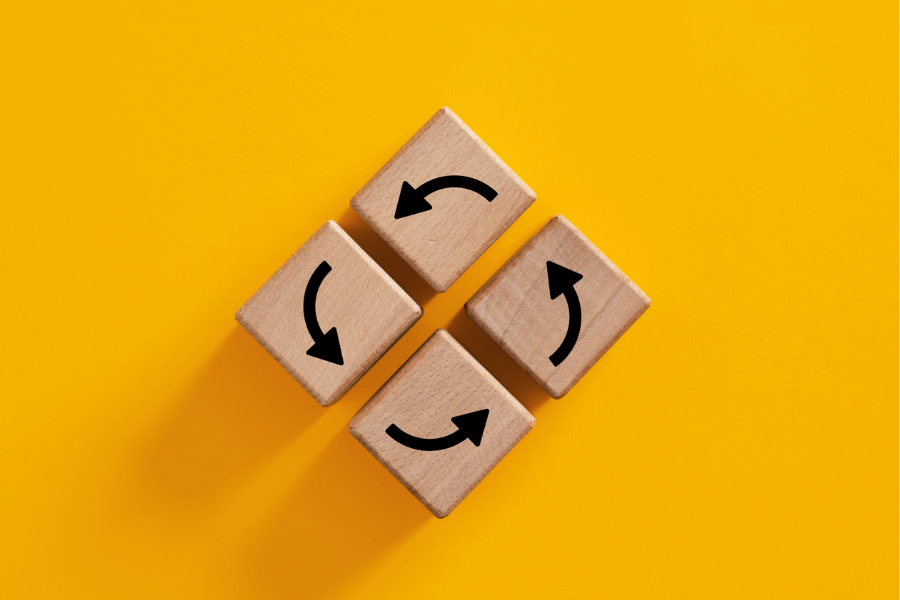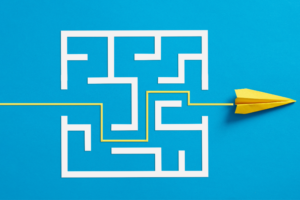Habit creation has become the darling of pop science quick-fix aficionados. To stack or nudge? Is grit the secret to success? Is repetition all it takes? Despite its infancy, habit research is packed with insights into crafting lasting behaviors. Yet, more often than not, we are offered solutions that lack applicable advice for habit formation. And while it’s fair to say nuance gets lost attempting to relay lessons of mice tapping buttons for food to more complex topics like human weight loss, we can do better. I think somewhere between Pavolv’s dog and Wansink’s retractions rests solid research on using habits to pursue our goals and achieve our desired outcomes.
This article is part one of a five-part series:
1) Why Habits Matter For Goals & Outcomes
2) Why is it so Tough to Change your Habits?
3) The Essential Mechanics of Changing your Habits
4) Creating Routines to Help Habits Stick
5) Crafting Environments to Support Your New Habits
Let’s get started with the first article!
A quick look at habits: cues to reinforcement
In article 3, I’ll dive into detail about how habits are formed. However, to explain why habits matter to our goals and outcomes, I need to give you a brief primer on how they work.
A habit is a stable and contextual loop that starts with a cue and ends with a result. For instance, seeing your running shoes next to the door could serve as a cue, initiating a desire to exercise. This cue sets off associated behavior actions (going for a run). Engaging in this behavior travels the habit loop to produce a result (the experience of the run and a sense of accomplishment). This outcome reinforces the cycle, leading to a stronger association between the cue (seeing your running shoes) and the behavior (going for a run). Over time, if repeated, this stable sequence of events gains automaticity where starting the action is performed with minimal conscious effort (making exercise part of your routine). Thus, a habit is created. Once the habit is created and reinforced, the behavior (running) will take less effort to carry out consistently, eventually leading to the outcomes you were hoping to achieve with this new habit (increased aerobic fitness).
So, it’s essential to understand that habits operate using an automatic cycle stemming from stable contextual conditioning. From the moment you rise until you fall asleep, you run off a collection of neurological and social subconscious operations. What you do in the morning, how you get dressed, the route you drive to work, and even how you think run via your subconscious and mix with other conscious behavior processes.

While habits interact with our conscious actions, they are more about subconscious patterns. It’s a dual process. Do automatic responses provide us with daily benefits? Do habits help?
At their core, habits function automatically to conserve resources and reduce cognitive load. While there is debate around ego depletion and mental resource allocation, evidence largely suggests that excessive decision-making can deplete these resources. Despite terminology disagreements, it’s accepted in behavior research that decision-making impacts our cognitive function. So, by helping us carry out a lot of behaviors without much conscious thought, habits help us save our mental energy for the decisions and behaviors we can’t just put on autopilot. Therefore, since habits run in the background of our daily decisions, it makes sense to condition them for what we want.
A simple illustration of habit loops, and the effort required to overcome habitual responses
In the next section, we’ll discuss how habits can influence larger outcomes like exercise and weight loss, but it might help to start by discussing a study that helps illustrate several of the key features of habits in a simplified manner.
In a study by Hardwick et al, participants were split into groups based on their duration of practicing keystroke tasks: minimal practice, four days, and 20 days. Participants used keystrokes in response to displayed visual signals to develop a habit. For example, every time a square flashed on the screen, you might need to tap “1,” and every time a circle flashed on the screen, you might need to tap “2,” etc. The participants placed their fingers on specific keys, each corresponding to one of four unique symbols displayed on a screen. Then, they were asked to press the correct key as quickly as possible whenever one of these symbols appeared. This linked the visual cue and the keystroke.
When the symbol-response maps (layouts) were altered, the researchers tested the participant’s ability to switch between the learned habit and the new requested (goal) action. In other words, when a square flashed on the screen, you might now need to tap “3” instead of “1.”
The findings show that those who had practiced the original keystroke tasks for 20 days made more errors when the task changed than people with less practice (minimal practice or four days of practice). This points to the impact of habit being more ingrained, making it harder for them to switch to the new goal. Additionally, they had quicker response times for incorrect answers, indicating that the habits became more automatic and harder to suppress and replace with the new goal-directed behavior, ergo, more errors.
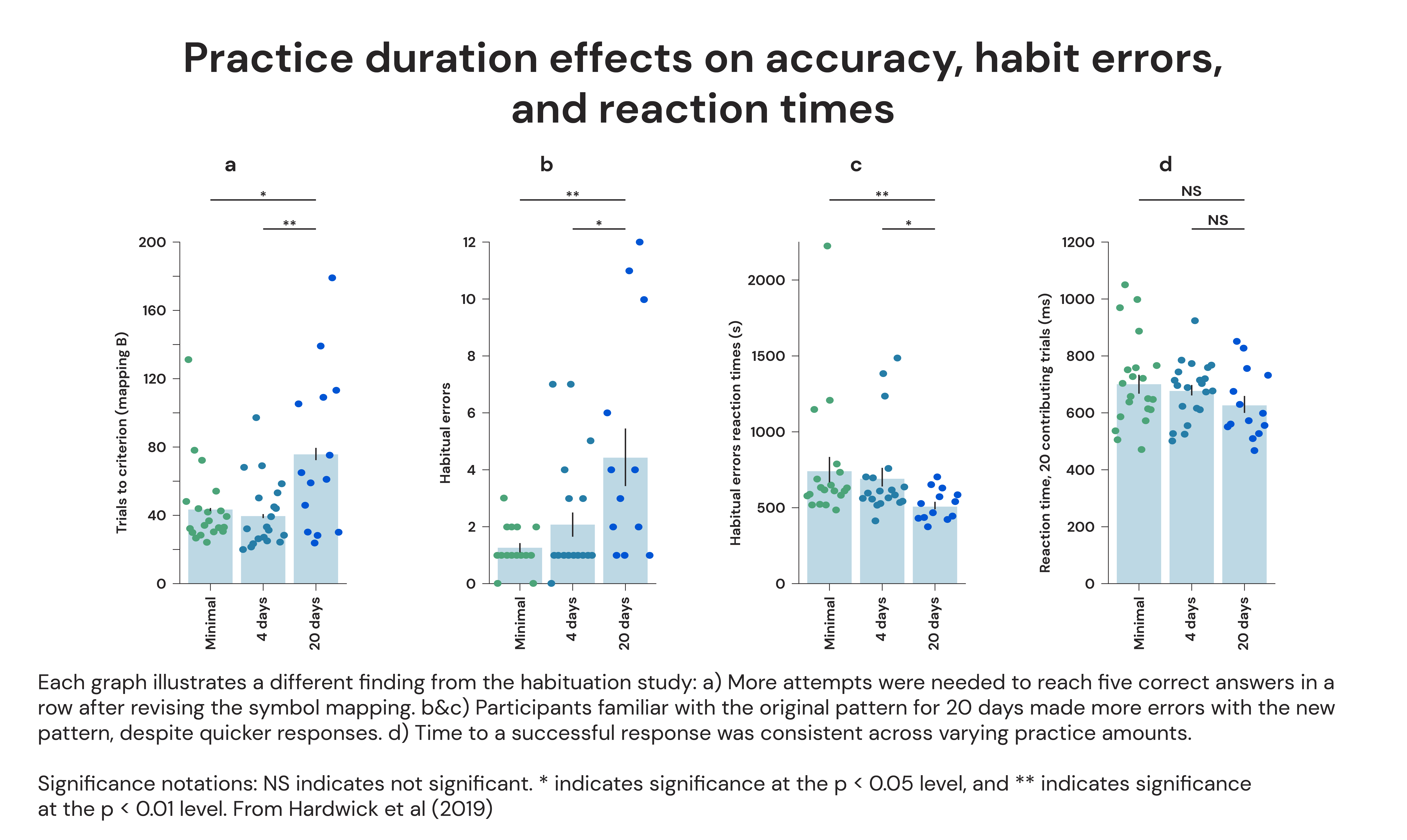
This study illustrates a few key characteristics about habits. Habits function on automatic feedback loops, with those feedback loops becoming more ingrained with greater reinforcement. Furthermore, habits aren’t destiny: conditioned habitual behaviors can be replaced with goal-directed behaviors. But, when a habit is more ingrained, it’s more likely that a cue will result in a habitual behavior, and more mental effort is required to replace the habit with a new goal-directed behavior.
While it might seem far-fetched to use keystroke habits to discuss complex behavior change, there are plenty of parallels. This study highlights that habits operate automatically, conserving mental resources. Mental resources are finite, and by managing those resources, we manage cognitive load. And yes, most tasks are not button-punching, but if we understand the base nature of a habit, we can increase its complexity in reasonable doses.
On one last note, sometimes the keystroke studies create a deflated feeling if you’re overwhelmed by your habitual responses. However, I implore you to embrace your optimism, as these studies also mean you can push through older, more ingrained habits and train new ones. It goes both ways.
Looking at habits through the lens of our goals, not a black-and-white filter
Ideally, we should view our habits from the perspective of a goal. Meaning, you have goals you want to achieve, and habits are a means to attain them. So, it’s helpful to frame habits, not as good or bad, but as constructive or counterproductive. Constructive habits help you achieve your goals. Counterproductive habits detract from or create barriers to your goals.
Changing that perspective frees us from shame associated with our less-desired habits while nipping undeserved self-nods. Additionally, framing habits with goals means you have clearly defined intentions. And as you’ll see in the upcoming articles, intentions contribute to successful habit formation.
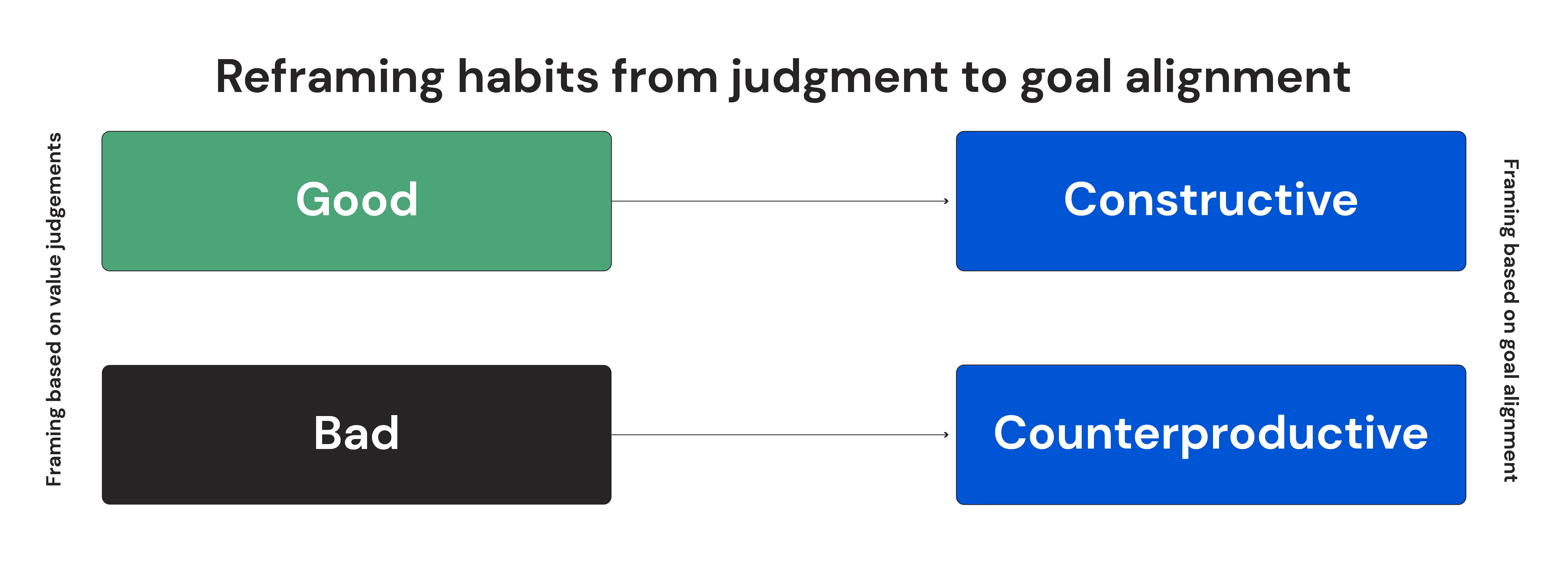
So, habits are what we do and who we are, but not always who we want to be. Most of us categorize habits as good or bad, often congratulating ourselves for the former and flogging ourselves for the latter. However, technically, habits are neutral, running off contextual cues having little to do with wants or intentions. For example, a study looking at smoker’s habits investigated how smokers would react after a ban was passed in UK pubs. They found the smokers, despite not meaning to do so, lit their ciggies inside the pubs after the ban. It was not defiance but environmental habits that led them to light up.
For every study in which participants add a desired new automation, say eating more fruit or taking more walks, another shows them reinforcing undesired behaviors, such as eating stale popcorn at movie theaters, simply out of habit.
Research continually affirms our goals and intentions are not our habits. Therefore, if we are unaware, our habits will work in the background, looking for the easiest or most familiar behavioral patterns, even if those behaviors are counterproductive for our goals. Being aware of this dynamic can help us gain an edge because often, the problem is that we are unaware that our habits are not working in unison with our goals. In our attempts at behavior change, we need to become aware of our habits, so that we can try to align our habits with our behavior change intentions.
If you’re reading this and thinking, “You’re not making me feel great about setting goals,” you shouldn’t be thinking that at all! Counterproductive habits can make goal pursuit much more difficult, but we can also use habits as a foundation of our goals, and make our habits work for us. Yes, our habits run automatically. However, you can influence that automatic behavior and create a goal-supported backup system.
The impact of habits on longer-term goals and outcomes
To support this line of thinking, let’s look at a meta-analysis and meta-regression study on behavior change and habit formation in the context of physical activity. It reviewed 10 studies involving 2,349 participants and found that interventions positively increased physical activity habit strength. In more straightforward terms, the methods designed to help us form new habits also help maintain healthy behaviors. It’s a symbiotic relation that supports a cycle where our habits help our behavior, and our behavior helps our habits.
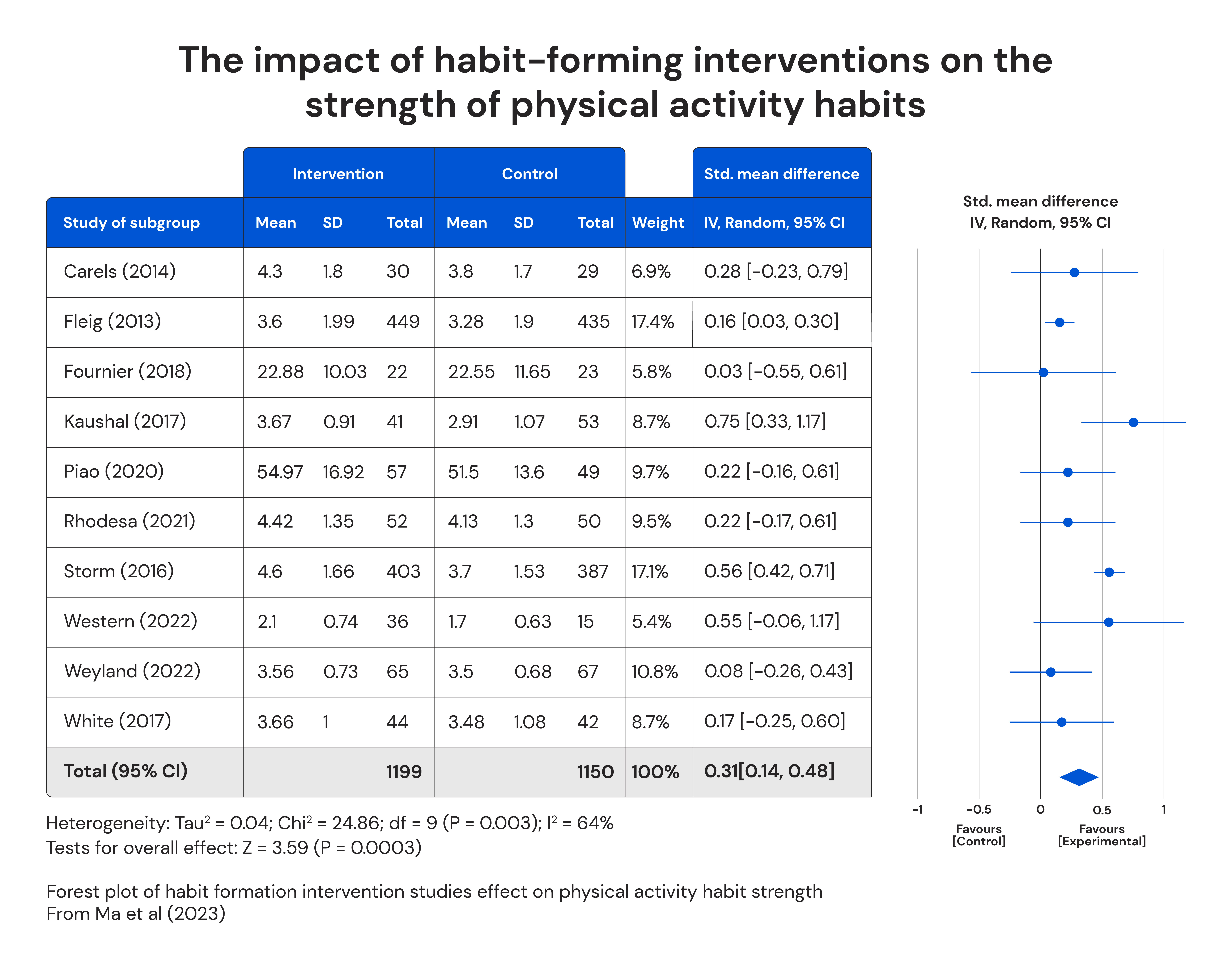
Small but clinically beneficial outcomes were also found for weight loss in a systematic review and meta-analysis of five trials involving 630 participants. The intervention participants were 2.4 times more likely to achieve meaningful weight loss (≥5% weight reduction), and post-intervention weight loss was 1.4kg greater in habit-based intervention groups than in control groups.
All of this highlights the potential strength of habit formation in working toward our goals. Later in the series, I’ll discuss room for improvement and (possibly) more substantial outcomes. If we tweak our approaches and application of habit formation, we gain a greater advantage.
Trying it all together in the real world
Let’s say you’re driving home after a demanding day that has drained both your physical and mental energy. The route is familiar, taking you past a fast food joint you often visit. This sight, combined with your current state, acts as a powerful cue. It triggers the habit of picking up your favorite combo meal.
However, a conflict exists because, contrary to that habit, you’ve recently set a goal to eat what you cook at home. Additionally, you’re trying to eat more vegetables and lean protein with a goal of losing body fat. Going home supports your goals. Stopping at the fast food joint does not.
At this moment, you’re fighting against a habit with diminished cognitive resources due to the demands of your day.
In this scenario, can you muster up the self-discipline to beat the habit? Of course. But the more critical tone I’m trying to strike is that the habit has the home-field advantage. Habit has privilege. In that moment of resisting, you’re conditioned to do something beyond simple wants. And while it’s easy to paint the combo meal as bad and the home-cooked meal as good, that’s actually not the point. Remember, habits are neutral. If your habits don’t support your goals, overcoming them might take more effort than you can give.
This scenario is an example of ego depletion and automaticity at play. To reduce resource demand, we execute the habit. Again, research indicates that when our mental resources are depleted, we are likely to fall back on habitual behavior, regardless of whether it is constructive or counterproductive. It’s the keystroke. Habits serve as the default. Habits require less mental energy and effort.
Now, let’s consider the same demanding day. What if you’ve developed a habit of going to the gym after work? And that habit includes consistently eating a pre- and post-workout snack you take with you. Also, what if the gym causes you to take a different route home? If the habit of stopping at a fast food joint is replaced, you’re still moving automatically. You’re still firing subconscious habits. On a demanding day, you’re still moving toward your goals. You succeeded not because you overcame temptation with willpower but because you conditioned a habit to work for you.
And this is why we should attempt to condition habits. It’s not that habits are a paradigm of perfection and all the answers to our goals. We still have to condition them in the first place. However, if you achieve constructive conditioning, habits show up to automatically support your goals.
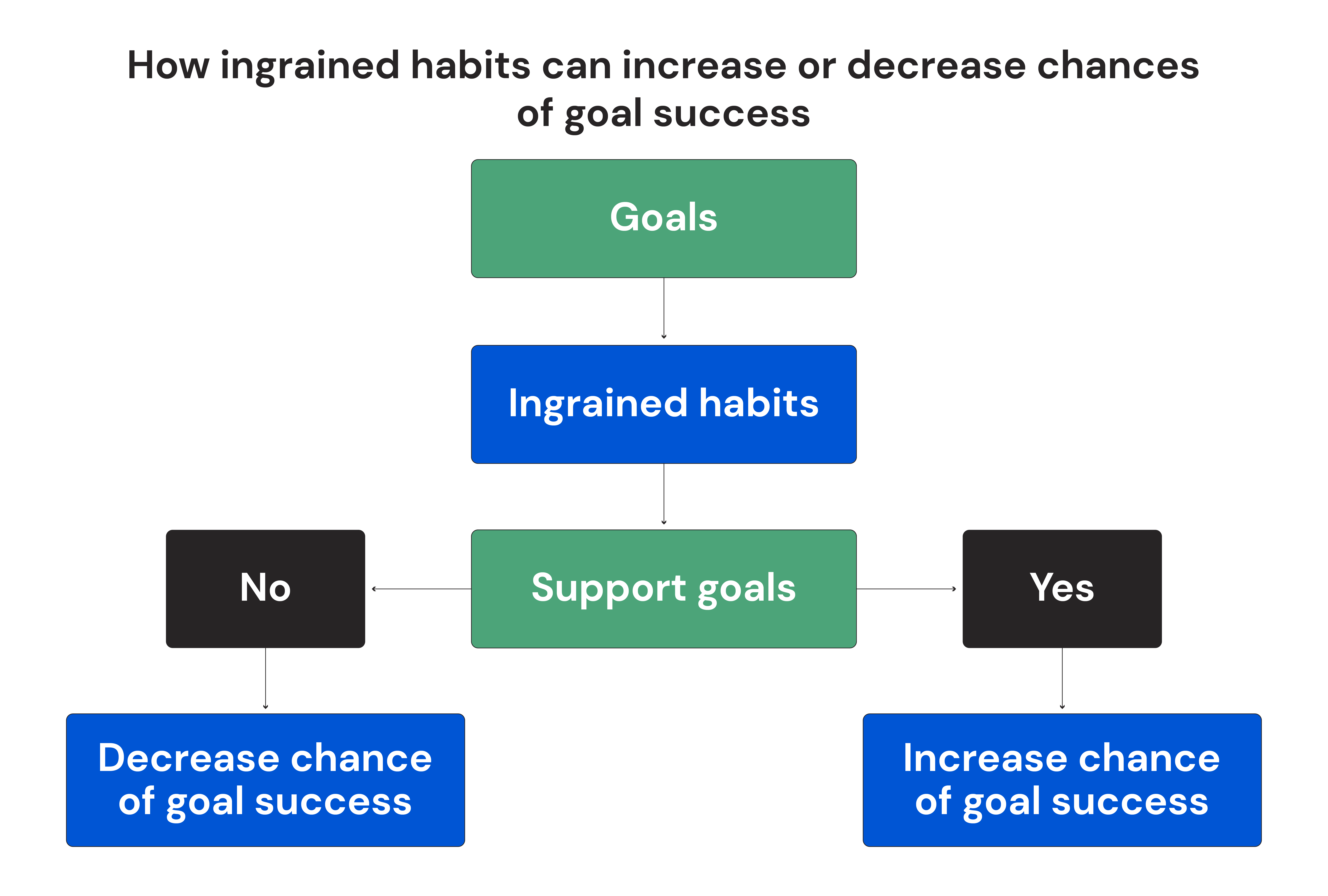
We see benefits from improving automation in almost every area, from work to health. If you want to floss more, study better, resist food temptation, or exercise more, improving automaticity supports your goals.
Homework assignment: Studies of habit formation
In this series, we don’t just want to stay in the realm of theory – we want this series to provide you with clear, actionable steps to help you change your habits to support your goals. This section bridges the gap between concepts and action planning, offering a path to implement habit formation into your daily life.
We’ll explore these steps using a follow-along example of an individual’s journey from the beginning to the end of the series. You’ll see how each article builds upon the last to support habit formation. However, I’d like to highlight that these strategies can be adapted to suit any goal or level of expertise. Whether you’re a bodybuilder trying to get “exotically lean,” or a brand new dieter who’s simply trying to be consistent with food logging, these strategies can be scaled to your needs.
As you read the case studies, consider how these concepts can apply to your goals and specifically how building a new habit can assist to achieve those goals.
Case study 1: Increase physical activity via walking after dinner
Casey is a 44-year-old freelance graphic designer who works from home and wants to counteract a sedentary lifestyle by incorporating more physical activity into their daily routine. Their objective is to add a 30-minute walk after dinner each day.
Clarify your primary habit goal: “I want to walk for 30 minutes after dinner every day to increase my physical activity and support my weight loss goals.”
Identify existing counterproductive behaviors: “Sometimes I eat dinner at erratic times, so I put off walking because I wait too late to eat. Also, I often sit and watch TV after I eat, which is not helping me work toward my goals.”
Identify existing constructive behaviors: “I like listening to podcasts when I walk. I also enjoy walking after meals and feel that I earn relaxation time when I’m done. Focusing on these things can help me with my goals and habit formation.”
Case study 2: Eliminate high-calorie snacking while watching tv/streaming
Riley is a 30-year-old account manager who tends to snack on high-calorie food while watching TV or streaming movies. Riley’s goal is to eliminate this habit, hoping it will also help meet their goal of losing 20 pounds of fat.
Clarify your primary habit goal: “I want to stop snacking on high-calorie food while watching TV or streaming.”
Identify counterproductive behaviors: “I grab snacks when I sit down to watch TV or movies in the evening. It’s my time to escape. I also buy particular food knowing I’ll consume them during that time. It’s not helping me work toward my goals.”
Identify constructive behaviors: “Sometimes I make low-calorie herbal tea that I enjoy drinking very much. I also like veggie platters and dips quite a bit; I just never make them. Focusing on these particular things can help me form better habits and achieve my goals.”
Your assignment:
At the end of each article, take a moment to document each insight lesson for your own journey. How can you relate this to your current habits and behaviors using the framework provided. At this time, don’t be concerned with making changes or altering anything. This is merely about identifying the habit you’d like to make (or break) and your counterproductive and constructive behaviors.

